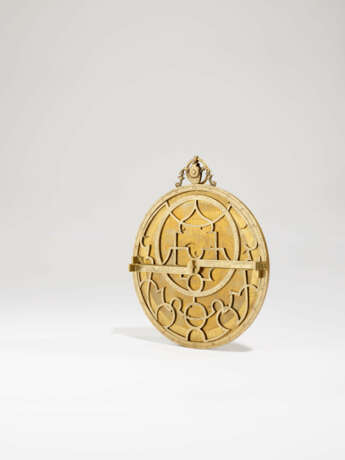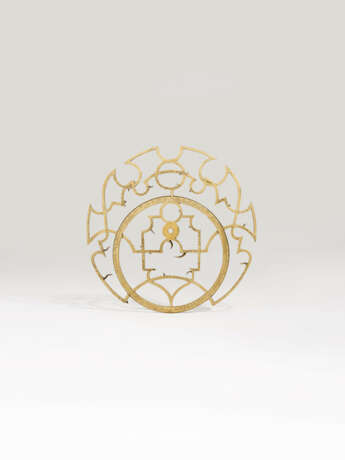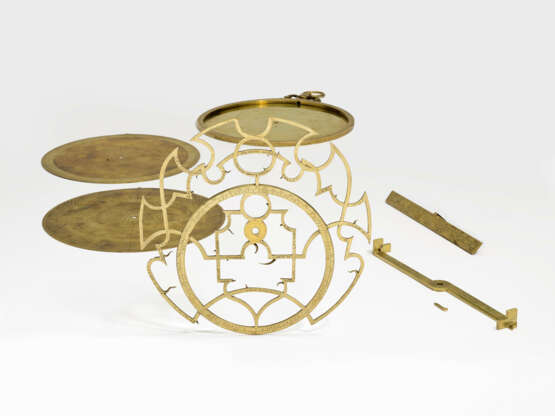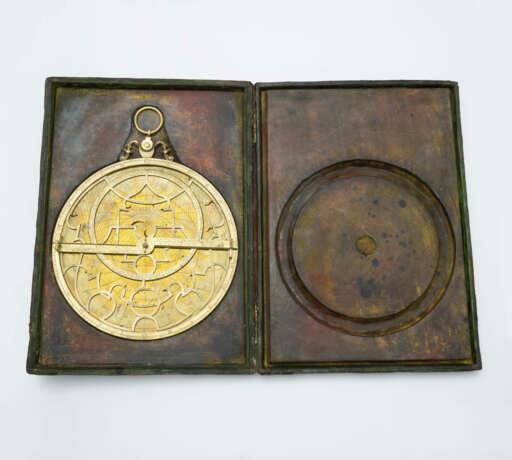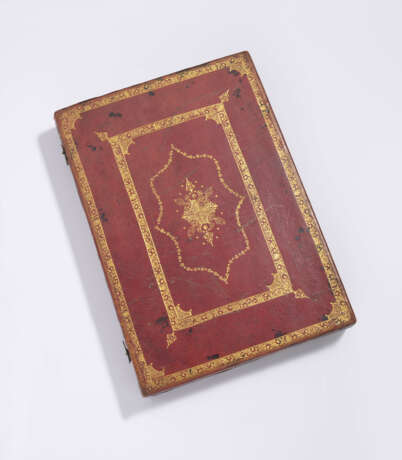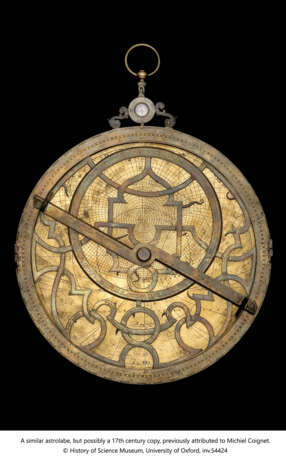ID 992795
Lot 18 | A LARGE BRASS HISPANO-FLEMISH ASTROLABE
Estimate value
£ 250 000 – 350 000
Attributed to Petrus Ab Aggere, (Madrid or El Escorial, after 1582)
The throne is composed of two S-shaped brass scrolls with foliage ornament, symmetrically placed against a central shield, with swivel and ring. The rim is engraved with one central scale divided in 360 units serving outermost for degrees, numbered every 10, four times 0-90° (clockwise from top: 90°-10; 10°-90°; 90°-10°; 10°-90°), innermost for the hours, numbered every hour in Roman numbers (clockwise from top: 1-XII; I-XII). Each unit is marked and engraved alternating with hachures and every fifth unit is indicated by an extended division line.
The inside of the mater is engraved with a quadratum nauticum as designed by Gemma Frisius and published in his treatise on the astrolabe of 1555. The square is graduated in 10° and numbered on the North side (Longitudo minor – Longitudo maior) and West side (Latitudo minor – Latitudo maior), engraved are straight line connecting all four sides, resulting in a grid of 324 squares. Radiating from the center are 36 straight lines framed by the square, alternating indicated with engraved directions of the winds in elegant italic script (clockwise starting from the North: Norte, Nornerdeste, Nordeste, Lesnordeste, Leste, Lesueste, Sueste, Susueste, Sur, Susudoeste, Sudoeste, Oessudoeste, Oeste, Oesnoroeste, Noroeste, Nornoroeste). The four cardinal points are engraved outside the square: Septentrio, Oriens, Meridies, Occidens. The left-over space at the East and West side, is occupied with an engraved circle.
On the reverse, the outer rim is engraved with three concentric scales: outermost is a combined one that serves for 360° degrees on the outside, numbered clockwise from the top : 90°-0-90°-0-90°, division for single degrees and numbered every 10th degree. Inside the scale serves for the zodiac, with engraved constellations in italic and numbered every 10°. Further inside is a scale for the calendar, numbered every 10-20 and final day of the month (February with 29 days) The spring Equinox (first point of Aries) coincides with March 21, indicating that the instrument was made after the calendar reform of 1582. Innermost is a scale of 360° relating to the universal stereographic project at the center. This is scale is number four times 90°-0 in clockwise direction.
The stereographic projection is engraved with celestial co-ordinates for single degrees, with the curves marked for every 10°. At 80° latitude at Zenith and Nadir the longitude curves stop. The hour lines are indicated by stamped letter from 1-12 at the tropics.
On top is a (later) rotating cursor graduated for 360° for the zodiac in units of 10°, numbered every 10° and indicated with the engraved zodiacal symbols.
There are two plates with the same design: the front side with a stereographic projection for on latitude, the reverse with a projection of the twelve zodiacal houses for the same latitude as on the front: 37° and 40° respectively. The lay-out is as follows: azimuth circles for every 10°, but left unnumbered; almucantars for every 2°, numbered every 10° on the azimuth running straight Southward from the zenith. The three concentric circles representing both tropics and the equator are drawn and the latter is indicated with engraved capital letters spread of ten units if the hours: AEQVINOCTIALIS. The oblique horizon is also labelled with engraved italic letters: Horizon obliquus. The curves for finding the unequal hours link both tropics and are numbered (clockwise from W, 1-12, every hour) in Roman numbers along the hours line between Tropic of Capricorn and the Equator. The latitude is indicated between the Tropic of Cancer and the Equator, labelled: Ad latitudinem gr. 37 and Ad latitudinem gr. 40.
The reverse is completely occupied with a projection of the twelve astrological houses, both tropics, the equator and the oblique horizon. Each of the twelve houses is subdivided in ten, number 1-12 in Roman capitals on top of the Tropic of Capricorn. The cusps radiate from the most Northern position on the horizon, where a circle is left open to indicate the same latitude as on the reverse: Elevatio poli 37 and Elevatio poli 40, encircled with the label referring to its function as astrological directory: DIRECTORIVM.
The symmetrical design of the rete is well balanced with its strapwork pattern, clearly inspired by the design introduced by Gerard Mercator around 1540 in Louvain and further elaborated by Gualterus Arsenius from 1555 onwards. The scale of the zodiac on the beveled edge is numbered each 10° for single degrees, with the constellations indicated by their name in Roman capitals.
One arm of the (later) alidade is marked for the hours, Horae ortus solis, number 1-9 for every hour and Horae Occasus, numbered 3-12. The reverse side is engraved with scales for finding the declination North and South: Latitudo Meridio, numbered 10-20-23 1/2 and Declinatio Septentrionalis 10-70, numbered every 10°.
In a modern gilt-tooled red morocco case, incorporating earlier elements.
Diameter: 9 7/8 in. (250 mm.)
Provenance
Staatliche Museen zu Berlin, KGM - inv. n. 3494.
Acquired as part of an exchange by W.P. di Koln in 1982.
Acquired from the W.P. di Koln collection by the current owner in 2001.
Literature
F.A. Dreier, Winkelmessinstrumente, Berlin, 1979, no. 7, pp.89-90.
F. Casi, Between Earth and Sky, Arezzo, 2021, pp.262-270.
Special notice
This lot has been imported from outside of the UK for sale and placed under the Temporary Admission regime. Import VAT is payable at 5% on the hammer price. VAT at 20% will be added to the buyer’s premium but will not be shown separately on our invoice.
| Place of origin: | Europe |
|---|---|
| Auction house category: | Clocks - Furnishings |
| Place of origin: | Europe |
|---|---|
| Auction house category: | Clocks - Furnishings |
| Address of auction |
CHRISTIE'S 8 King Street, St. James's SW1Y 6QT London United Kingdom | |
|---|---|---|
| Preview |
| |
| Phone | +44 (0)20 7839 9060 | |
| Buyer Premium | see on Website | |
| Conditions of purchase | Conditions of purchase |




